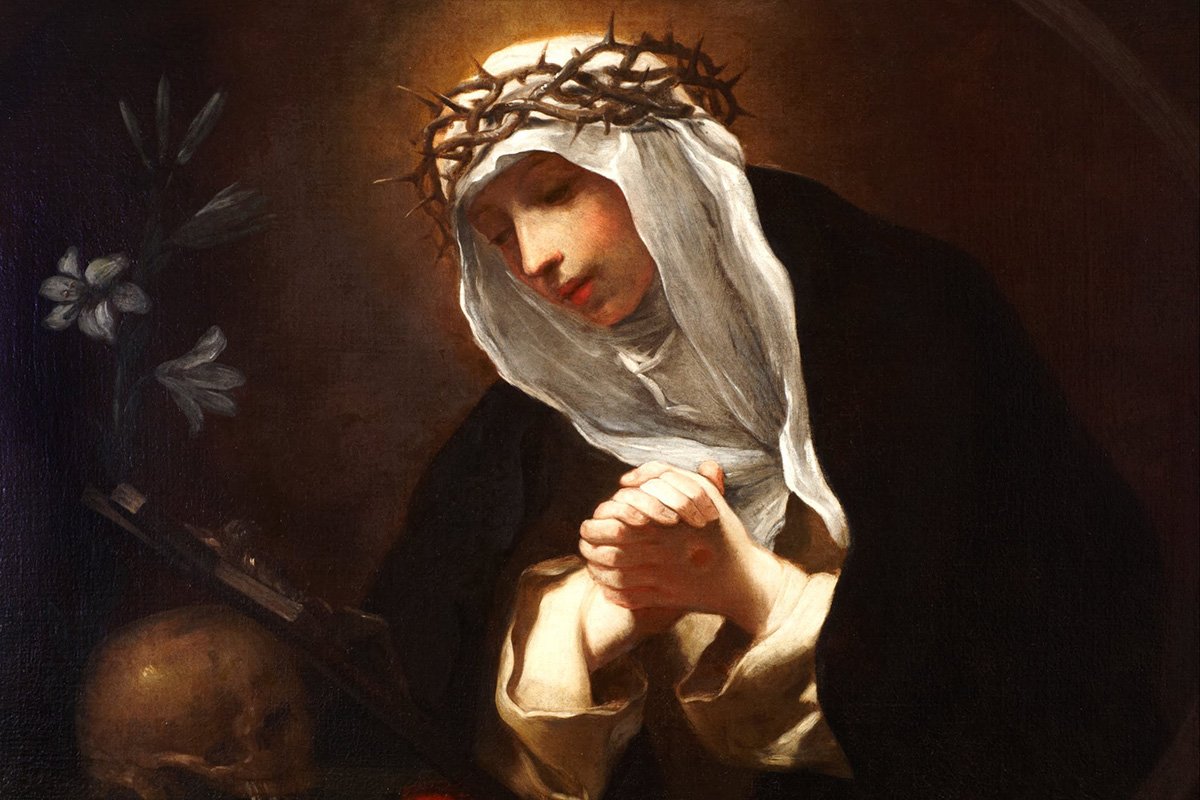
Diagnosing Saints
Identifying health issues in religious exemplars can help reduce stigma and illustrate that virtue and mental illness are not mutually exclusive, but we must hold such diagnoses lightly.
This week marks the feast of Catherine of Siena, the day on which millions of Catholics worldwide venerate this fourteenth century Italian saint and Doctor of the Church, who died at the age of thirty-three after a prolonged fast. The circumstances of her death have led some historians and psychiatrists (of both professional and armchair varieties) to suspect that Catherine suffered from undiagnosed anorexia.
Catherine is not the only religious figure whose mental health has come under scrutiny in recent years; the increasing awareness of mental illness and the existence of Reddit have led to a proliferation of such diagnoses. Some claim that the twentieth century philosopher and mystic Simone Weil also died of anorexia. Other religious figures are said to have had obsessive-compulsive disorder, including Catholic saint Thérèse of Lisieux, Puritan preacher John Bunyan, and Protestant reformer Martin Luther.
Yet such attempts to diagnose mental illness among saints and other spiritual exemplars are fraught. Examining why experts think we should be skeptical about these retrospective diagnoses, and why people make these diagnoses anyway, can help us better understand the complex relationship between religion, psychiatry, and historiography.
The first obvious challenge with retrospective diagnosis is lack of data. It is questionable how much we can know about the mental health of individuals who lived centuries before our own. An official diagnosis of mental illness can only be offered by a licensed professional after a personal evaluation of a patient, and even under these conditions, misdiagnosis is common. Even the most air-tight historical record cannot replace the insights of a face-to-face interview. If it is possible for professionals to miss or misinterpret the symptoms of mental illness that are under one’s nose, this may be taken as a note of caution for those practicing without a license with fragmentary historical evidence.
Then, there is the problem of anachronism. Retrospective diagnoses typically rely on criteria found in the Diagnostic and Statistical Manual of Mental Disorders, which has existed in different editions for less than seventy-five years. When these contemporary labels of mental illness are applied to historical figures, it is often without regard for the complex cultural, social, and religious conditions in which those individuals lived.
It may be tempting to view the diagnostic criteria as definitive and historically stable. Indeed, the DSM is often referred to as the “bible” of psychiatry, an epithet indicating the text’s authority within the field. Yet for those with even cursory knowledge of biblical studies, this comparison is doubly apt, reflecting the DSM’s complex and contested nature. Diagnostic criteria have changed substantially since the fifties and have often been the source of controversy. For instance, homosexuality was identified as a mental illness in the early editions of the DSM but has since been removed.
Setting aside historical problems, it is worth recognizing that diagnoses are intended to identity an underlying disorder, in the service of providing effective treatment. It is worth asking why one would attempt to diagnose long-deceased individuals, given that they are not around to benefit from treatment.
I suspect that retrospective diagnosis reflects a form of reductionism, an attempt to reduce complex religious phenomena down to the level of the brain and biology. Indeed, there is a natural human curiosity to seek explanations and labels for puzzling instances of human difference. (Perhaps a similar impulse underlies the contemporary affinity for astrological symbols and personality tests, by which every individual can be neatly slotted into a comprehensive set of categories.) Such reductive curiosity may be benign, though it might lead us astray.
In some cases, reductionism reveals a more cynically motivated impulse, by which these diagnoses are a form of dismissal. Some might argue that the spiritual phenomena in the lives of religious figures are reducible to psychological factors. On this view, the dark night of the soul becomes nothing more than a case of major depression, and the miracles of the saints are nothing more than hallucinations.
This tendency towards reductionism is not new. William James explores this problem in his 1902 Varieties of Religious Experience. He defines the problem as one of “medical materialism,” a way of explaining a spiritual state in terms of its physiological origin to discredit that state. He writes, “Medical materialism finished up Saint Paul by calling his vision on the road to Damascus a discharging lesion of the occipital cortex, he being an epileptic. It snuffs out Saint Teresa as a hysteric, Saint Francis of Assisi as a hereditary degenerate.” Having identified the cause of these occurrences, “medical materialism then thinks that the spiritual authority of all such persons is successfully undermined.”
But James thinks that these explanations fail to explain away the spiritual process at play. He offers the example of someone whose experience of God is dismissed as a fever-induced haze. He responds, “for aught we know to the contrary, 103° or 104° Fahrenheit might be a more favorable temperature for truths to germinate and sprout in, than the more ordinary blood-heat of 97 or 98 degrees.” It could well be the case that saints experienced mental illness, but such acknowledgment does not discredit the spiritual state attested to.
To be sure, identifying mental illness in religious exemplars can reflect a welcome move towards destigmatizing mental illness, and a recognition that virtue and mental illness are not mutually exclusive. We can surely take comfort in the fact that the saints were humans in all ways as us, including in mental illness. We can acknowledge this, all while holding these diagnoses lightly, remaining cautious of the impulse to apply to the twenty-first-century labels of the DSM to beloved figures of the past.
Featured image: Saint Catherine of Siena by Baldassare Franceschini, 17th century


